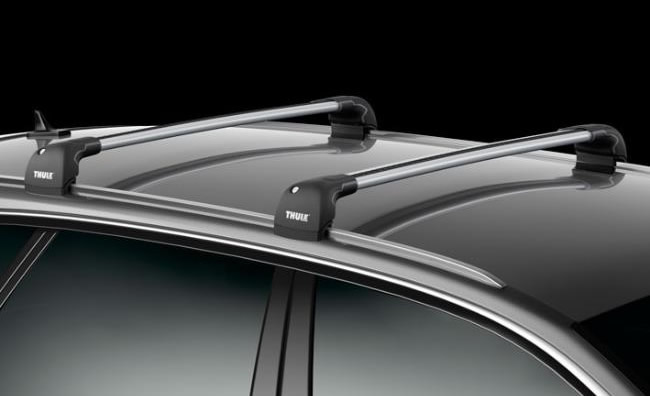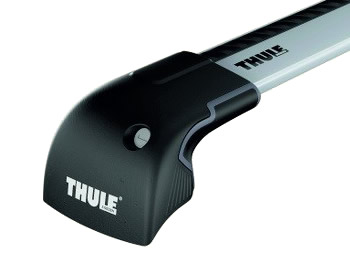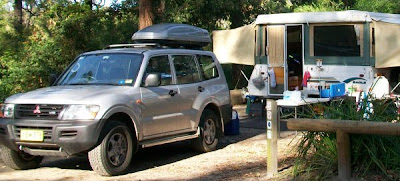Choosing a Roof Luggage Box for your car - Steve Minshall
There is a huge choice of luggage boxes for carrying gear on the roof of your vehicle. Also known as roof pods, roof boots, capsules and sometimes by the brand name Thule boxes, they come in a bewildering range of styles and sizes not to mention prices. In this blog we will try and help you navigate your way through the choices to help you work out which boxes best suit your needs and budget.
At Shop1Auto in Sydney we can supply over 25 varieties of luggage boxes from Thule, Rhino, Yakima nd Rola. Prices range from $399 for a small, cheap and cheerful, Chinese, mass produced box all the way up to $1750 for the ultimate Thule Excellence roof box. So how have these manufacturers taken what is essentially a large suitcase on your roof and created such a diversity of products. Well there are several considerations when choosing a roof box which can be divided into the following:
- Size and shape
- Orientation of opening
- Weight capacity
- Ease of fitment
- Compatibility with roof racks
- Style
- Warranty
Common features of Thule, Rhino, Yakima and Rola luggage boxes
When you choose any of the roof pods we supply from Thule, Rhino or Rola you will find some consistent features as a minimum. The boxes will have some sort of attachment system supplied with them and any holes needed for attachment will be pre-drilled. The top shell moulding will have some degree of UV resistant cap so that the box doesn’t become brittle after the first week in the sun. All the boxes have a number of locking points operated by a central key lock. The side supports are sprung loaded to assist with both opening and closing. The basic moulded construction is the same for all boxes as typically they are vacuum formed over a mould from 2 sheets of plastic such as ABS or ABS/ASA.
Size and shape
What do you want to carry?
What size box will fit your car?
Do you want to carry additional gear like bikes/surf boards at the same time?
The first consideration with a roof rack luggage box is what do you want to put in it? Your basic choices for boxes is wide but short, long and thin or wide and long, ie big! If you want to carry bulky gear like camping equipment then the most economical way of getting volume is to go for a shorter wide box. Then for skis or if you also want to carry additional gear alongside you can get a long thin box. Finally you can get boxes that are both long and wide which will cover all uses.
The recommendation would be to get the largest box that fits your budget but your vehicle may put some limitations on what box you can carry. Surprisingly this does not necessarily equate to the size of the car but is more to do with where the roof racks are on the roof and if you have a lift up rear door that will conflict with the luggage box. Even some large 4WD do not have much space between the roof racks and the position of the rear door in its upright position. As a general rule if you want to carry something long like skis but have a lift up tail gate you should go for the shortest box that will take the load.
The volume of luggage boxes is measured in litres. Typical figures are around the 370ltr for a small box, 450 to 480ltr is the most popular range for general luggage then large boxes can be as much as 650ltrs for the massive Thule Motion 900. To give the sizes some perspective you can consider that a late model Commodore has boot size of around 600ltrs.
The shape of the box has a great bearing on the looks and style of a luggage box but this can introduce compromises. For example the Thule Dynamic range is really aerodynamic, sleek and low profile but this comes at the expense of internal height. On the other hand the Rhino Windrider 450 is very popular as an economical way of getting a large volume. However, it does look a bit of a brick and even its mother thinks it’s ugly.
Weight Capacity
Also to consider along with the space available in the box is the weight rating. Within the Thule, Rhino, Rola ranges you can find 50kg and 75kg rated boxes. Generally the 50kg units rely upon the shape of the moulding to give them their strength and structure. The 75kg rated boxes have some sort of metal reinforcing to boost the carrying weight. Obviously a 75kg rated box is more useful than a 50kg rated box but something to consider when deciding on the additional expense is the rating of your roof racks. If you allow 15kg for the weight of your box then your roof racks themselves need to be rated to at least 65kg before you start to get any benefit from this extra box rating.
Orientation of opening
Luggage boxes come in the following configurations:
Open drivers side
Open passenger side
Open both sides
Open from the rear
The dual side opening boxes offer the optimum practicality especially for taller vehicles because you do not have to reach right across the roof to get items that may be in the back of the box and also it greatly simplifies the tightening of the attachment mechanism that secures the box to the roof racks. Most single side boxes are now available with more practical curb side opening although Thule also have some boxes that open on the driver’s site which can suit some peoples circumstances. Rear opening boxes are generally smaller units, be aware that the lock is usually in the centre on a rear opening box which is ok if you can reach from the back of the vehicle but can be a stretch on sedan.
Ease of fitment
Currently you can choose between the Thule ‘Power-grip’ and ‘Fast-grip’ claws or a more basic u-bolt attachment. The Thule system is very effective as the 4 claws slide along a channel so that you do not need to line up any holes in the box with your cross bars. To tighten you simply wind 4 knobs inside the box and your done. U-bolts hold the box very securely but are more fiddly to attach and also with up to 20 components there are lots of bits to lose in between uses
Compatibility with Roof Racks
There are two issues with your roof rack cross bars that may effect the choice of a luggage box. Firstly is the position on the roof and secondly the width of the cross bar profile. Many roof racks have a specific location on the roof dictated by the roof rack manufacturer or there may be dedicated mounting points incorporated into the car roof. This can cause issues when trying to line up u-bolt holes on the cheaper boxes.
The second consideration is the cross sectional width of the roof racks. The wider the roof rack the less flexibility you have with positioning of u-bolt style mountings. Also some boxes are not compatible with the modern wing style cross sections designed by Prorack. For example their Whispbar roof racks which are also currently used by several car manufacturers as Original Equipment roof racks branded as Holden, Mazda or Honda for example. These are best suited to the Thule claw mounting systems which are able to accommodate the width.
Style
Thule have really pushed for style with their top end boxes. The Thule Excellence with its gloss finish and two-tone colouring looks outstanding and the Thule Dynamic range also looks great but they do come at a premium price. Cheaper boxes are usually a flat grey or black colour while the more expensive boxes are treated to an attractive glossy skin. This is introduced at the Thule Motion and Yakima Sky Box Pro range with boxes various boxes available in Silver, Black and Anthracite gloss finishes.
Warranty
Ask about warranty, some boxes have 3 years and some have 5 years and Yakima have a remarkable lifetime warranty on their Sky Box Pro range.
Summary
So finally you have boxes ranging from $399 to $1750. Decide what features are important to you, size, weight rating, orientation of opening, ease of fitting and looks. Then take a look at our website at www.shop1auto.com.au for the specs of different models and current pricing. It is then worth talking to a roof rack specialist like Shop 1 Auto to see if there may be any issues with your particular car or to recommend a suitable roof rack system if you need this as well.
What do I use when I go camping and skiing? An old Thule Atlantis 780.




































